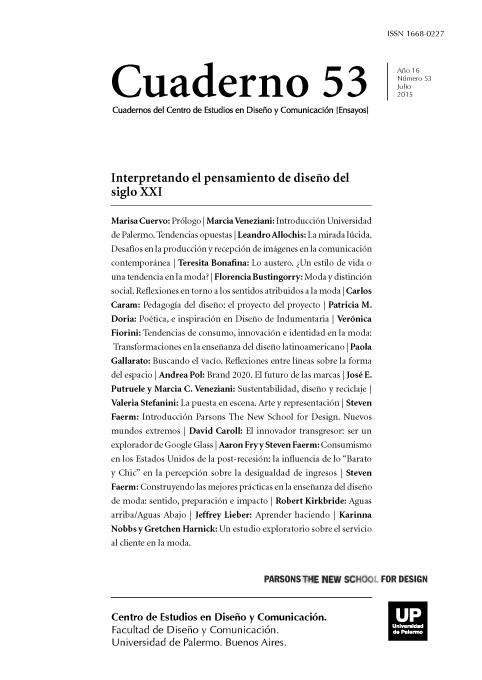The Transgressive Early Adopter: Being a Google Glass Explorer
Abstract
With the advent of commercially available wearable computing devices, our technologically driven marketplaces accelerate an increasingly designed, mediated, and networked lifestyle where connected sensors, cameras, and display screens embed themselves onto our bodies rather than merely resting in our pockets and palms. This first phase of wearable computers includes bracelets containing sensors and wireless radios to track motion and activity toward a “quantified self” through data and personal context,
mostly towards fitness and health objectives. Far less discreetly, Google Glass, the eyewear device with an integrated camera and a prism display positioned above the line of sight is perhaps the most startling and controversial new product that tests the boundaries of wearable utility and social acceptability. At the time of this writing, only hand-selected “Glass Explorers” are able to purchase the device as Google market-tests the product with “influencers” and early adopters. The author was accepted as an evaluation user of Glass and offers a personal and critical analysis of the experience here as a way of pointing towards a near future of increasingly wearable computing that infiltrates the body and its relationship to our social and spatial contexts.
References
Anonymous. (2013, December 12). White men wearing Google Glass. Retrieved from http://whitemenwearinggoogleglass.tumblr.com/
Behind the pictures: Tonne Goodman. Vogue. (2013, August 21). Retrieved from http://www.vogue.com/vogue-daily/article/behind-the-pictures-tonne-goodmans-the-final-frontier/
Bush, V. (1945, July 1). As we may think. The Atlantic. Reprint retrieved from http://www.ps.uni-saarland.de/~duchier/pub/vbush/vbush-all.shtml
Carroll, D. (profcarroll). “#ifihadglass I’d use my research funds to buy Google Glass and have my students and faculty @mfadt write insanely great software for it”. 22 February 2011, 10:55 p.m. Tweet. Retrieved from https://twitter.com/profcarroll/status/305163836074389504
Carroll, D. (2014, February 11). Birthday ‘make vignette’ command generated POV image. [Google Glass image JPG file]. Retrieved from http://pic.twitter.com/4qBx3lTB7L
Carroll, D. (2014, January 1). Instagram. Retrieved from http://instagram.com/p/irCBUGItbD/
Crabapple, M. (2014, January 7). Google Glass, the corporate gaze and mine. Rhizome. Retrieved from http://rhizome.org/editorial/2014/jan/7/google-glass-male-gaze-andmine/
Franken, A. (2014, February 4). NameTag letter, United States Senate, Committee on the Judiciary. Retrieved from http://www.franken.senate.gov/files/letter/140205NameTagLetter.pdf
Grant, R. (2014, February 6). Refresh unveils Google Glass app that presents ‘instant dossiers’ on people you meet. VentureBeat. Retrieved from http://venturebeat.com/2014/02/06/refresh-unveils-google-glass-app-that-presents-instant-dossiers-on-people-you-meet/Google. (n.d.). Google Glass Explorers. Retrieved from https://sites.google.com/site/glasscomms/glass-explorers
Jones, C. A. (2008). Going beyond the body. In Fan, D. & Zhang, G. (Ed.), Synthetic Times. (1st ed., pp. 30-45) Cambridge, MA Beijing, China: MIT Press National Art Museum of China.
Jonze, S. (Writer, Director, Producer) (2013). Her [Motion Picture]. United States: Warner Bros. Pictures.
Klein. S. (2013, August 21). Google Glass and a Futurist Vision of Fashion. Vogue. Retrieved from http://www.vogue.com/magazine/article/the-final-frontier-google-glass-andfuturistic-fashion/
Klein, S. (2013, August 21). Command and Control. Vogue. [photo, JPG file]. Retrieved from http://www.vogue.com/magazine/article/the-final-frontier-google-glass-and-futuristicfashion/#/magazine-gallery/the-final-frontier/5
Klein, S. (2013, August 21). Bang! Pow!. Vogue. [photo, JPG file]. Retrieved from http://www.vogue.com/magazine/article/the-final-frontier-google-glass-and-futuristic-fashion/#/magazine-gallery/the-final-frontier/6
Kurzweil, R. (2013, July 17). First attack on a cyborg. Retrieved on 2014 February 24 from
http://www.kurzweilai.net/first-attack-on-a-cyborg
Lardinois, F. (2014, February 9). Google Hopes its Roadshows Will Help Normalize Glass. TechCrunch. Retrieved from http://techcrunch.com/2014/02/09/google-hopes-itsroadshows-will-help-normalize-glass/
Mach, E. (1897). Contribution to the Analysis of Sensations [italicized as is]. (Dover, 1959 ed., p. Section 9). Chicago: The Open Court Publishing Company.
Mann, S. Left-to-right: Perpetrator 2 tearing up my doctor’s letter, while Perpetrator 3 watches. Steve Mann’s Blog. Retrieved from http://eyetap.blogspot.fr/2012/07/physicalassault-by-mcdonalds-for.html
Mann, S. (2013, July 17). Physical assault by McDonald’s for wearing Digital Eye Glass. Retrieved from http://eyetap.blogspot.com/2012/07/physical-assault-by-mcdonalds-for.html
Shteyngart, G. (2013, August 5). O.K., Glass: Confessions of a Google Glass Explorer. The New Yorker. Retrieved from http://www.newyorker.com/reporting/2013/08/05/130805fa_fact_shteyngart?currentPage=all
Seymour, S. (2008). Fashionable Technology: The Intersection of Design, Fashion, Science, and Technology. New York, NY: Springer.
Sterling, B. (2011). Augmented Reality: Vannevar Bush Cyclops Camera. Wired. Retrieved from http://www.wired.com/beyond_the_beyond/2011/07/augmented-reality-vannevarbush-cyclops-camera/
Steve Mann. (n.d.) In Wikipedia. Retrieved 2014 February 24 from https://en.wikipedia.org/wiki/McVeillance#McVeillance_and_the_Mann-Wassel_Law
Tsukayama, H. (2014, February 26). Anti-Google Glass attack in San Francisco highlights tension over wearables. The Washington Post. Retrieved from http://www.washingtonpost.com/business/technology/anti-glass-attack-in-san-francisco-highlights-tensionoverwearables/ 2014/02/26/b3f21e44-9eeb-11e3-9ba6-800d1192d08b_story.html
Vidhyanathan, S. (2011). The Googlization of Everything: (And Why We Should Worry). Berkeley: University of California Press.
Wassel, P. (2013, November 20). Proposed law on sousveillance. Retrieved from http://www.webcitation.org/6DGWgAmau
Los autores/as que publiquen en esta revista ceden los derechos de autor y de publicación a "Cuadernos del Centro de Estudios de Diseño y Comunicación", Aceptando el registro de su trabajo bajo una licencia de atribución de Creative Commons, que permite a terceros utilizar lo publicado siempre que de el crédito pertinente a los autores y a esta revista.


